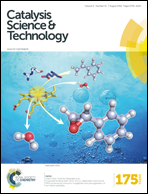The effects of the Mo–Sn contact interface on the oxidation reaction of dimethyl ether to methyl formate at a low reaction temperature†
Abstract
With increasing degrees of Mo–Sn interface contact, the molar ratio of methyl formate (MF) to methanol (MeOH) and formaldehyde (FA) was found to linearly increase at the same time, which indicates that a high degree of MoO3 and SnO2 interface contact has a strong positive effect on the conversion of the methoxyl intermediate to MF in the dimethyl ether (DME) oxidation reaction. XRD and Fourier transform EXAFS indicate that the structure of molybdenum oxide starts to change from MoO3 clusters to oligomer MoOx domains with an increase in the degree of Mo–Sn interface contact, and the Mo–O–Sn structure begins to dominate at the contact interfaces when the degree of interface contact increases to 0.0256 and 0.0384 nm2 SnO2/Mo atom. HRTEM also confirms the presence of the MoOx domains on the surface of the catalyst possessing the smallest molybdenum oxide content, the signals of which were even undetected by XRD and Raman. Moreover, ESR, XPS and XAFS suggest that Mo5+ species exist in the Mo–Sn contact interfaces rather than on the surface of the catalysts. The evaluation results of MoO3-SBA-15 further verify the key role of Mo5+ in the formation of MF. Therefore, Mo5+ is reasonably proposed to be the active center for the formation of MF in the DME oxidation reaction. Based on the catalytic characterization results, the reaction pathway of DME oxidation to MF via methoxyl intermediates was proposed on the Mo(V) sites. First, DME was absorbed and consequently dissociated to become an absorbed methoxy-Mo(V) species with the assistance of acidic sites and lattice oxygen. Then, the β-H was eliminated, and an absorbed FA-Mo(IV) species was formed. Consequently, the absorbed methoxy-Mo(V) species reacted with the neighboring absorbed FA-Mo(IV) species, producing MF, and then, the Mo(IV) species was regenerated to become an Mo(V) species by the oxidation of O2 so it could catalyze another reaction cycle. The deeper understanding of this investigation has substantial meaning for the preparation of a catalyst with a specific molybdenum oxide structure that can be applied for transforming the methoxyl intermediate to produce other high-value products through the DME oxidation reaction.


 Please wait while we load your content...
Please wait while we load your content...